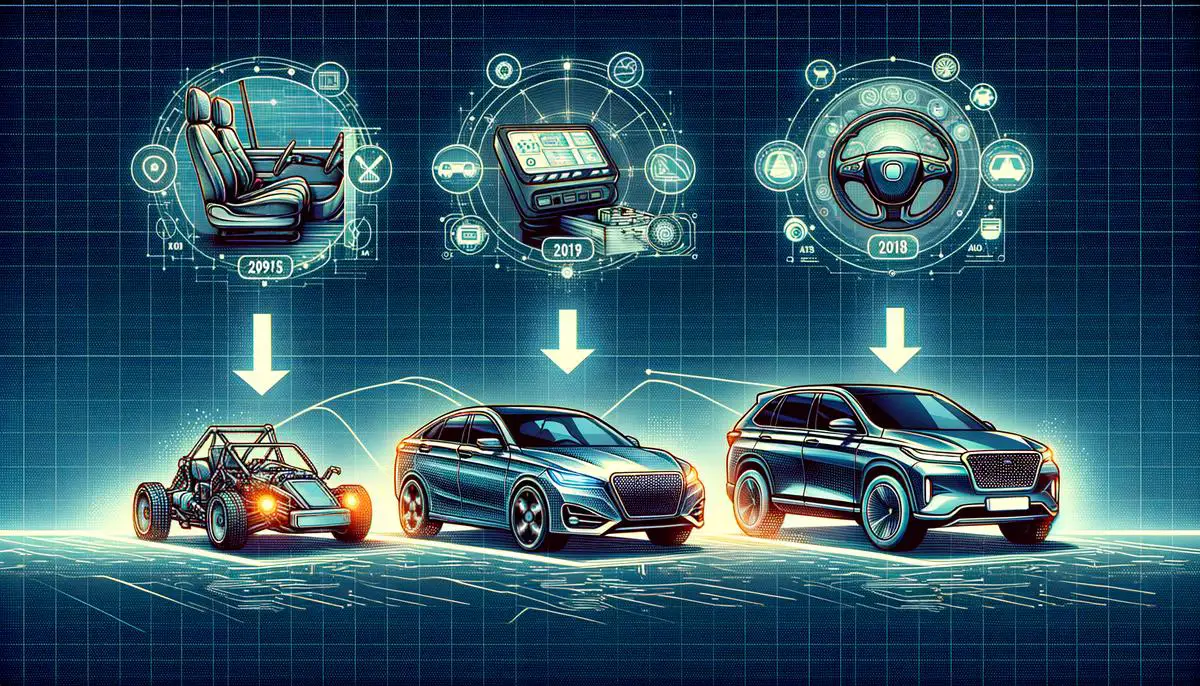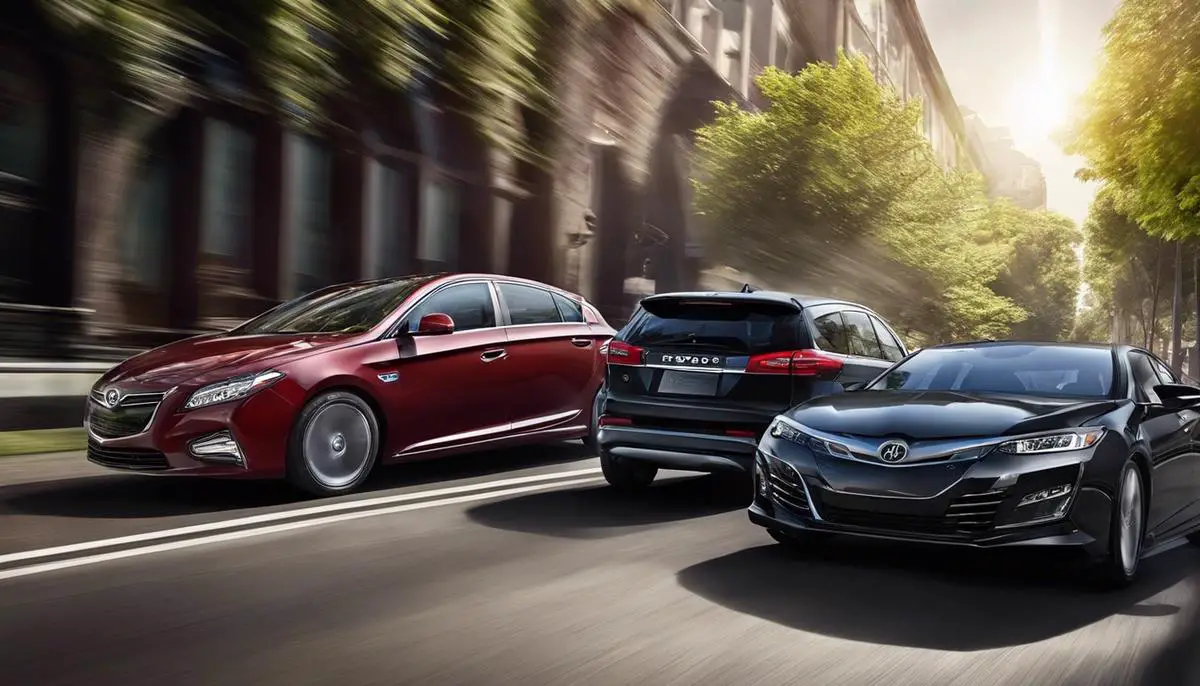The journey of vehicle safety has been a long and winding road, marked by significant technological advancements and a growing awareness of the importance of protecting passengers and drivers alike. From the early days of airbag development to the sophisticated automated systems that define modern vehicles, this narrative traces the evolution of safety features that have become integral to our driving experience. As we navigate through the history and future trends of vehicle safety, we gain insight into how these innovations have shaped, and continue to shape, the way we think about road safety.
Contents
The Genesis of Airbags
Airbags started as a wild idea in the minds of safety innovators, aiming to protect passengers during a crash. The journey from concept to car staple involves a mix of engineering brilliance, tenacious advocates, and policy evolution. In 1941, the patent for the airbag was filed, laying the groundwork for future safety measures. Yet, it wasn’t until the 1970s that airbags began appearing in vehicles as optional safety enhancements, a testament to technological progress and changing attitudes towards passenger safety.
The real momentum for airbags picked up in 1973 when General Motors introduced them in some of their models. This move marked a pivot in auto safety, showing a glimmer of the potential lifesaving impact of airbags. However, widespread adoption was slow, as concerns over cost and effectiveness loomed. It wasn’t just about slapping an airbag into a car; engineers were tasked with creating a system that could sense a collision’s imminent impact and deploy quickly enough to cushion passengers.
By the 1980s, the dialogue around airbags shifted from optional luxury to a potential mandate. Public safety campaigns and mounting evidence of airbag effectiveness in saving lives helped turn the tide of opinion. Key to this change was the relentless push from safety advocates and governmental bodies, culminating in 1991 when the Intermodal Surface Transportation Efficiency Act mandated that by 1998 all new cars must be equipped with airbags for the driver and front passenger.
This legislation acted as a catalyst for further innovation. Automakers not only began standardizing front airbags but also looked into expanding protection. This led to the development of side airbags, curtain airbags, and even knee airbags, further enhancing passenger safety in a variety of collision scenarios.
Technological advancements played a crucial role, making airbags smarter and more reliable. Sensors became more sophisticated, able to detect the severity of a crash and adjust airbag deployment accordingly. This ensured that airbags would not cause harm during minor incidents while providing maximum protection during severe crashes.
The impact of airbags on vehicle safety has been profound. Statistical data from the National Highway Traffic Safety Administration (NHTSA) highlights the effectiveness of airbags in reducing fatalities in direct frontal crashes by up to 30%. This statistic underscores the significance of airbags as a critical component of vehicle safety systems.
Moreover, the introduction of global regulations and testing standards has reinforced the importance of airbags in achieving high safety ratings. Automakers striving for the coveted five-star safety rating view airbags as indispensable tools in their arsenal.
In the landscape of vehicle safety, airbags have moved from an experimental feature to a mandatory requirement, illustrating a remarkable journey of technological achievement and regulatory success. Through relentless innovation and advocacy, airbags have cemented their role as guardians of the road, continuing to evolve with every model year.

Automated Braking Systems
Automated braking systems use a combo of radars, cameras, and lasers to keep an eye out for potential trouble on the road. When these gadgets sense something might be amiss, like another car getting too cozy or an unexpected obstacle popping up, they immediately tell the car’s computer brain. This brain isn’t just any old processor; it’s super smart and can figure out lickety-split if braking is needed to dodge a collision or lessen its smack.
Once this brainy system decides it’s go-time for braking, it doesn’t just tap the brakes like one might cautiously test the water with their toe. Nope, it goes all in, applying the brakes with just the right amount of gusto needed to prevent a crash or make hitting something less of a disaster. This action is lightning fast, way quicker than a person could react, smuggling in an extra layer of safety you didn’t even know you needed.
Now, it’s not like automated braking systems are a one-trick pony; oh no, they’ve evolved over time. Initially, they were more about giving drivers a heads-up with beeps and lights, kind of like tapping a person on the shoulder saying, ‘Hey, you might want to watch out.’ But, technology being the never-sleep beast it is, improved these systems into proactive guardians of the asphalt, stepping in to brake when drivers are caught off-guard.
One might ponder the legit question: Do these high-tech aides actually make a difference? Well, the answer’s a resounding ‘Yes!’ Studies have validated that cars equipped with automated braking systems are noticeably less likely to experience a rear-end bonk. By lessening the likelihood and severity of crashes, these smart systems have become heroes in reducing injury-related claims, proving that they’re worth more than their weight in microchips.
Furthermore, with roads busier than a bee hive in spring, having that extra set of electronic eyes ready to brake in an emergency isn’t just a nice-to-have; it’s practically a must-have for keeping the unpredictable unpredicted. Be it a wayward pedestrian who hops into the street willy-nilly or the sudden stop of traffic that catches drivers by surprise, automated braking systems are always on, ready to reduce the ruckus by cutting down collision chances.
In terms of road safety enhancement, automated braking systems don’t just add a layer; they’re weaving a whole safety net. By drastically slashing the risk of rear-end smashes and encouraging more attentive driving habits, they have nestled warmly into the core strategy for making roads safer. Plus, let’s not overlook the cherry on top: these systems could help ease the congestion on car insurance bills by being the bouncer that wards off fender benders and their ensuing claims.
So, as we motor along in this ever-changing landscape of car technology, automated braking systems stand out as a shining example of how smart innovation can take the wheel to steer us closer to roads less traveled by accidents. They’re not just a technological marvel but a genuine buddy keeping vigil on every turn, making sure the only crashing happening is the sound of waves against the shore on a tranquil holiday, far from the hustle and bustle of traffic.

The Role of Advanced Driver-Assistance Systems (ADAS)
Advanced Driver-Assistance Systems (ADAS) elevate vehicle safety to new heights by supporting the driver in numerous critical driving situations. Lane-keeping assistance, a standout among these features, nudges the vehicle back into its lane if it veers off course unintentionally. This subtly champions road safety by combating driver fatigue and distractions, making long drives on highways a tad less daunting.
Further down the road of innovation, adaptive cruise control takes the wheel, metaphorically. Unlike traditional cruise control that maintains a steady speed, adaptive versions dynamically adjust a vehicle’s speed to maintain a safe driving distance from the car in front. This intuitive feature reads the flow of traffic with eagle-eyed precision, reducing the driver’s workload and minimizing the chances of tail-end collisions caused by sudden stops.
Blind-spot detection acts as the driver’s vigilant co-pilot, monitoring the hard-to-see areas to the side of the vehicle. When another vehicle enters this invisible zone, the system alerts the driver with visual or auditory warnings. This pivotal aid turns lane changing from a nerve-wracking game of chance into a safe, informed decision.
Together, ADAS features forage into uncultivated territories of vehicle safety by bridging the gaps in human perception and response. By augmenting the driver’s awareness of their environment, these systems significantly pare down the risks of human error. Mistakes like drifting out of lane, misjudging distances at high speeds, or overlooking vehicles in blind spots become much less probable.
The synergy between these advanced systems crafts a bubble of situational awareness around the vehicle. Cameras, sensors, and radars work in concert, painting a comprehensive picture of the immediate vicinities. This constant stream of real-time data funnels through sophisticated algorithms that empower the vehicle to anticipate and react to potential hazards faster than a blink.
As vehicles grow smarter, embracing an array of sensors and smart systems, road trips transform into journeys escorted by digital guardians. Each ADAS feature contributes an essential thread in this safety net, weaving a stronger barrier against common roadway perils.
The ascendancy of these technologies signals a seismic shift towards proactive safety measures on the roads. By trimming down the margin for human error, ADAS extend a promising road to fewer accidents and safer travels for everyone. With every car equipped to sense, decide, and act autonomously within fractions of a second, the avenues to a future with drastically reduced road mishaps widen.

The Impact of Vehicle Design on Safety
Vehicle design has a monumental impact on the safety outcomes in the event of a crash. Crumple zones, for example, are engineered to collapse in a controlled manner, absorbing and distributing the force of the impact away from the passenger compartment. The concept behind crumple zones is derived from the simple physics principle that force distributed over a wider area results in less force impacting any single point. This ingenious use of physics directly contributes to reducing the risk of injury for passengers by lessening the shock transmitted to them.
Following the logic of energy distribution, the vehicle frame strength plays a crucial role. Car frames designed with high-strength steel or alloys can withstand higher impact forces, making them a key line of defense in a crash. These materials are chosen for their balance between flexibility and rigidity. Just as a skyscraper needs to sway with the wind but remain upright, a car must be able to absorb impact without crumbling. The strategic placement of these materials throughout the vehicle’s structure not only protects passengers but also plays a part in the overall handling and stability of the vehicle on the road.
Safety features within vehicles are not just add-ons but are integral to the holistic design aimed at protecting lives. Their placement is meticulously calculated for optimum functionality. Take side airbags and curtain airbags as examples; they are positioned to provide maximum protection against side impacts and rollovers, scenarios where traditional front airbags wouldn’t suffice. This placement strategy is the result of countless simulations and real-world crash tests designed to understand the dynamics of crashes from every conceivable angle.
Principles of safe design extend beyond the immediate impact zone to include factors like visibility. Larger windows and better-designed pillars can significantly reduce blind spots, ensuring drivers have a clearer view of their surroundings. Enhanced visibility directly correlates with a driver’s ability to avoid potential hazards before they result in an accident.
Automotive designers also consider the ergonomics of vehicle interiors, recognizing that driver comfort and control are paramount for safety. Controls that are intuitively placed and easily accessible allow drivers to keep their focus on the road, minimizing distractions. Similarly, seats and steering wheels that adjust to support a comfortable driving posture can reduce fatigue on long journeys, keeping drivers alert.
In modern vehicles, the integration of advanced materials and technologies reveals a dynamic approach to improving safety. Features like automatic seatbelt tightenings and adjustable headrests are designed to position passengers in the safest possible manner during a collision, further evidence of how comprehensive the field of vehicle safety design has become.
The innovation doesn’t stop at structural design or feature placement; it’s also about how these elements work together synergistically. The interplay between crumple zones, vehicle frame strength, and safety feature placement combined with proactive safety technologies like automated braking systems, and passive safety features such as airbags, forms a multi-layered safeguarding strategy. This cohesive approach maximizes protection for passengers by addressing a broad spectrum of scenarios, from prevention to impact absorption and post-crash safety.
Each aspect of vehicle design, whether it be the material selection for the frame or the strategic placement of crumple zones, embodies a commitment to preserving life. It illustrates an ongoing evolution where every component, no matter how small, contributes to a greater ecosystem of safety. Through the advancement of vehicle designs focused on protective measures, automakers continue to push the envelope, turning vehicles from mere modes of transportation into fortresses of safety on wheels.

Future Trends in Vehicle Safety Systems
Emerging technologies point toward a future where vehicles communicate directly with each other, known as Vehicle-to-Vehicle (V2V) communication. This innovative leap holds the promise of reducing accidents by providing real-time information about the location, speed, and direction of nearby vehicles. When one car suddenly brakes, others around it get a warning, allowing them to react more quickly.
Autonomous vehicles, or self-driving cars, are making headlines for their potential to drastically lower accident rates. Equipped with sensors and advanced algorithms, these cars can navigate roads, avoid obstacles, and even make split-second decisions to ensure passenger safety. The development of fully autonomous systems might transform driving by removing human error, the leading cause of road accidents today.
Predictive safety features powered by artificial intelligence (AI) are setting a new standard. Through the analysis of data from in-car sensors and external sources, such as traffic and weather reports, AI can predict potential hazards and either alert the driver or take corrective action. This could include predicting pedestrian movement, foreseeing potential collisions, or assessing road conditions to adjust driving style automatically.
The rise of Electric Vehicles (EVs) introduces a different aspect of safety through higher standards for battery protection. Ensuring the safety of the lithium-ion batteries powering these vehicles has led to innovations in battery management systems which monitor voltage, temperature, and state of charge to prevent fire risks.
Digital connectivity inside vehicles adds another layer of proactive safety measures. Apps that monitor vehicle health in real time and alert drivers to issues such as low tire pressure or brake wear not only offer convenience but also ensure that vehicles are in optimal condition for safe driving.
Alternative materials and designs in vehicle construction play a critical role in enhancing safety standards. The application of high-strength aluminum and carbon fiber for their exceptional energy-absorbing properties improves vehicle durability upon impact, offering superior protection without compromising on weight or efficiency.
Augmented reality (AR) dashboards represent an upcoming trend aiming to keep the driver’s eyes on the road. By projecting critical information such as navigation directions, speed, and alerts directly onto the windshield, AR dashboards minimize distractions and improve driver awareness, making it easier to focus on driving safely.
Technology such as Light Detection and Ranging (LiDAR) offers 360-degree sensing capabilities, mapping out the environment around the vehicle with incredible precision. When integrated with other safety features, LiDAR enhances early obstacle detection and collision avoidance systems, contributing to safer road environments for everyone.
Eye-tracking technology furthers the endeavor of creating safer road conditions by monitoring driver alertness. Systems equipped with this technology can detect signs of drowsiness or distraction, alerting the driver to refocus or suggesting taking a break, thereby reducing the risk of accidents caused by fatigue.
As cybersecurity becomes a paramount concern with the advancement of connected cars and autonomous vehicles, developing secure systems to protect against threats and vulnerabilities is imperative. Industry efforts focus on creating robust cybersecurity frameworks to shield vehicles from potential hacking attempts that could compromise safety.
These advancing trends represent a radical overhaul of traditional car safety features and point towards a future where driving might become fundamentally safer. While fully realizing these technologies’ potential will require overcoming substantial engineering, ethical, and regulatory challenges, the ultimate goal remains clear: leveraging innovation to save lives and create a safer future for road travel.

In conclusion, the progression of vehicle safety systems from basic airbags to complex automated braking and driver-assistance technologies underscores a critical shift in automotive design philosophy. The paramount goal remains clear: to reduce road accidents and enhance the safety of all road users. By examining the past developments and looking ahead to future innovations, it’s evident that technology will continue to play a pivotal role in achieving safer travel. As we move forward, the commitment to improving vehicle safety is not just about adhering to regulations but about fostering a safer future for everyone on the road.



